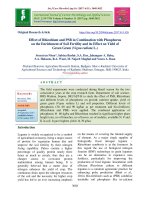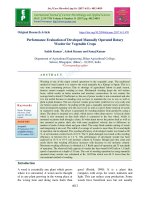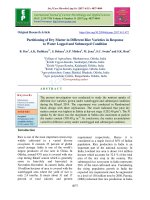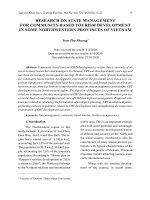Integration of solar PV systems into grid: Impact assessment and solutions - Trường Đại học Công nghiệp Thực phẩm Tp. Hồ Chí Minh
Bạn đang xem bản rút gọn của tài liệu. Xem và tải ngay bản đầy đủ của tài liệu tại đây (705.63 KB, 10 trang )
<span class='text_page_counter'>(1)</span><div class='page_container' data-page=1>
<b>INTEGRATION OF SOLAR PV SYSTEMS INTO GRID: IMPACT </b>
<b>ASSESSMENT AND SOLUTIONS </b>
<b>Prof. Tran Quoc Tuan</b>
<i>CEA-INES (French National Institute for Solar Energy) and INSTN (Paris Saclay University) </i>
<i>50 avenue du Lac Léman, 73377 Le Bourget-du-lac, France </i>
<i>e-mail: </i>
<b>Abstract</b>-- The integration of Renewable Energy Resources (RES) or PV systems into
grid, with the intermittent characteristics can have several impacts on the network
operation such as stability, protection and challenges for managing… Theses impacts
are more complicated for an islanded grid or weak grid. To facilitate the integration of
renewable energies into the grid, a concept of smart-grid is used. The smart grid uses
digital technology to improve reliability, flexibility, and efficiency (both economically
and energetically) of the electric system. This paper presents impacts provided by PV
systems integration into grid: voltage variations, frequency variation, voltage
unbalance… Several solutions in order to reduce these impacts, to maximize the
ancillary services contributed by PV systems are proposed via different projects.
Intelligent control and energy management are developed in order to minimize
operation cost and to maximize the RES penetration rate into grid.
<b>Index Terms</b>—Smart grid, microgrid, simulation, impact, stability, forecasting, control,
energy management, protection
<b>I. INTRODUCTION </b>
</div>
<span class='text_page_counter'>(2)</span><div class='page_container' data-page=2>
<b>TABLE I: Solar PV energy development in 2013 </b>
<b>Cum. Capa. Production Cum. Capa. Production </b>
2015 (GW) 2015 (TWh) 2016 (GW) 2016 (TWh)
1 <b>China </b> 43.53 78.07 66 (1.07%)
2 <b>Japan </b> 34.4 30 (3.4%) 42.75 43 (4.9%)
3 <b>Germany </b> 39.7 38.7 (6.5%) 41.22 41.7 (7%)
4 <b>USA </b> 27.32 26.5 40.3 59.8 (1.4%)
5 <b>Italy </b> 18.9 24.68 (7.8%) 19.28 25.1 (7.5%)
6 <b>UK </b> 8.8 7.56 (2.5%) 11.63 10.3 (3.4%)
7 <b>India </b> 5.1 9.01 7.45
8 <b>France </b> 6.55 7.42 (1.4%) 7.13 8.3 (1.6%)
9 <b>Australia </b> 5.1 5.9 2.4%
10 <b>Spain </b> 5.4 5.49 8 (3.2%)
<b>World </b> 242 303 1.8%
The connection of solar PV system to the grid, with intermittent characteristic, can
raise several technical problems or can have significant impacts on power systems
such as:
Varying the power production
Changing the voltage profile
Increasing the voltage unbalance between phases
Increasing harmonics on the network
The stability, the protection problem and the system management: with great
number of inverters connected to grid, the inertia of network is low, the
short-circuit currents are small…
<b>II. SOLAR PV POWER FORECASTING AND MONITORING </b>
The integration of variable PV systems into electrical grids is limited because of
their intermittences, fast power variations, high dependence on meteorology and low
inertia. The variability has to be characterized along a spatial and time dimension. For
spatial dimension, PV generation covering a large spatial extent can have an hourly
temporal resolution, while individual PV panel plants will have highly variable PV
power outputs in a short time. When power systems are operating with variable PV
systems, the operators have different major issues in different time scales.
</div>
<span class='text_page_counter'>(3)</span><div class='page_container' data-page=3>
to ensure power grid performances that satisfy reliability standards within an acceptable
cost. The forecasting of the power generation has been considered as a major solution to
handle efficiently PV system integration into grids. However, the uncertainty associated
with forecast errors cannot be eliminated even with the best models and methods. In
addition, the combination of generation and consumption variability with forecast
uncertainty makes the situation more difficult for power system operators to schedule
and to set an appropriate power reserve level.
Therefore, forecast information is essential for an efficient use, the management
of the electricity grid and for solar energy trading. At CEA-INES, three models for
forecasting the PV production have been developed based on stochastic learning
method, local and remote sensing method and hybrid method (Fig. 1):
Solar PV forecasting model for 6 to 48 h: this model uses the weather forecasting
Solar PV forecasting model for 30 min to 6 h: this model uses the satellites
images
Solar PV forecasting model for 5 to 30 min: this model uses the local camera.
<b>Fig. 1: Three models developed at the CEA-INES for forecasting of PV production </b>
</div>
<span class='text_page_counter'>(4)</span><div class='page_container' data-page=4>
<b>Fig. 3: Solar PV monitoring in France </b>
Fig. 2 shows a PV solar monitoring at a ski station “Le Pas du Lac”. Solar PV
monitoring stations in France is presented in Fig. 3. From the information obtained by
monitoring during one year (ex. in 2013 for this case), we can estimate the variability of
PV production from power plan (central) to country in France as shown in Fig. 4.
<b>Fig. 4: Variability of PV production from power plan to country in France </b>
<b>III. IMPACT ASSESSMENT OF PV INTEGRATION INTO GRIDS </b>
From random variables of PV production and loads, a probabilistic three phase
Load Flow (PLF) is developed by using Monte Carlo techniques. Two modes of
simulation can be realized by using this tool:
Deterministic simulation: all parameters are fixed
</div>
<span class='text_page_counter'>(5)</span><div class='page_container' data-page=5>
In particularly, the neutral currents and losses in neutral conductors are also
calculated. The program shows also:
Max or min values of these quantities and their occurrence
Distribution of over-voltage, under-voltage or overcurrent
Critical instants and locations (buses) in the network.
The developed tool based on the Monte Carlo simulation has the following
advantages:
A three-phase load flow program with a fast calculation
A simulation which takes into account the unbalance between phases (single or
three-phase loads)
An ability to determine the voltage unbalance and losses in neutral conductors
The identification of critical time, locations (buses) and occurrence probability of
load or PV production
An easy analysis of results with the help of proposed indicators.
The proposed program allows an assessment of the impacts of PV integration on
distribution and the determination of the penetration rate of PV systems. After
identifying the critical cases by using the developed tool, solutions can be developed
and re-evaluated in particular to avoid the congestion, to maintain voltage within
limits…
This tool is used for the Reflexe Project (smartgrid) in order to determine the
impacts of PV integration into the PACA (Côte d’Azur) Area in France (Fig. 5) and to
evaluate smart solutions such as PV integration, energy storage and load shedding.
There are voltage violations in this area (PACA) when a 400 kV line is outraged
between Realtor and Necules.
</div>
<span class='text_page_counter'>(6)</span><div class='page_container' data-page=6>
<b>Fig. 6: Voltage variation with N-1 </b>
<b>Fig. 7: Voltage variation with N-1 with solutions: PV+load shedding and PV+Storage </b>
In order to maintain the continuation of operation, several solutions are carried out
such as: PV installations, energy storage and load shedding. Fig. 7a shows the voltage
variation with 180 MW of PV and load shedding about 234 MW. Fig. 7b shows the
voltage variation with 180 MW of PV and 100 MW-200 MWh of energy storage. With
these solutions, voltages are maintained within limits.
This tool is also used to determine the maximal PV insertion capacity connected
to grid (Fig. 8). The maximal PV inversion capacity is determined by the constraints of
voltages and power flows. Fig. 9 show the voltage variation and power variation
without PV installations. With a PV system installed at bus 53, the maximal capacity of
PV system is 6.85 MW. For this case, they can have overloads on certain lines (Critical
lines:10-47, 47-48, 48-49, 49-50, 50-51, 51-52) and no voltage variation (Fig. 10a, and
10b). With PV systems installed at bus 53 and 61, the maximal capacity of PV system is
13.09 MW. For this case, they can have voltage violation at buses: 52, 53, 54, 14, 15, 61
and no overloads (Fig. 11a). With a PV system installed at bus 53, 36, 58, the maximal
capacity of PV system is 14.67 MW. (P_PV_36 = 6.51 MW, P_PV_53 = 1.31 MW,
0 5 10 15 20 25
0.94
0.96
0.98
1
1.02
1.04
1.06
Time (H)
V
ol
tage (
pu)
0 5 10 15 20 25
0.94
0.96
0.98
1
1.02
1.04
1.06
Time (H)
V
ol
ta
ge (
pu
)
0 5 10 15 20 25
0.94
0.96
0.98
1
1.02
1.04
1.06
Time (H)
V
ol
ta
ge (
pu
</div>
<span class='text_page_counter'>(7)</span><div class='page_container' data-page=7>
P_PV_58 = 6.85 MW). There are overloads on lines 9-33, 33-34, 34-36, 12-55, 55-57,
57-58.
<b>Fig. 8: Distribution network with PV installations </b>
<b> </b>
<b>Fig. 9: Voltage variation and power flow in lines </b>
<b> </b>
<b>Fig. 10a: Congestion; Fig. 10b: no voltage violation (P_PVmax = 6.85 MW) </b>
0 5 10 15 20 25
0.94
0.96
0.98
1
1.02
1.04
1.06
Time (H)
V
ol
tag
e (p
u)
0 5 10 15 20 25
0
0.5
1
1.5
2
2.5
3
Time (H)
B
ra
nc
h power
f
low (
M
V
A
R)
0 5 10 15 20 25
0
50
100
150
200
Time (H)
B
ran
ch
c
ur
ren
t(
A
)
0 5 10 15 20 25
0.94
0.96
0.98
1
1.02
1.04
1.06
Time (H)
V
ol
ta
</div>
<span class='text_page_counter'>(8)</span><div class='page_container' data-page=8>
<b> </b>
<b>Fig. 11a: Voltage violation (P_PVmax = 13.09 MW); Fig. 10b: Over load (P_PVmax = 14.67) </b>
<b>IV. CONTROL CAPABILITIES OF DISTRIBUTED ENERGY RESOURCE TO </b>
<b>PARTICIPATE IN DISTRIBUTION SYSTEM OPERATION </b>
This part presents a case study based on a real distribution network with a high
share of distributed generation. We built the simulation on the present network topology
and generated a scenario for the expected future with a high penetration of DER
(Distributed Energy Resources) and an increase of the consumption. Even with a load
growth exceeding the substations capacity the simulated network can be operated with a
high security of supply. This degree of power quality is guaranteed by controllable DER
units which are capable of operating in an islanded mode and of providing voltage
control and congestion management as ancillary services. Simplified models of
common DER units are described. They allow a simulation of a thousand-node network.
<b>Fig. 12: Distribution network in Valencia (Spain) </b>
The connection of DER (Distributed Energy Resource), in particular PV systems
to networks can raise a certain number of technical challenges. Important impacts are
the influence on the network’s voltage, the network’s stability and the security of
supply.
0 5 10 15 20 25
0.94
0.96
0.98
1
1.02
1.04
1.06
Time (H)
V
ol
tag
e (pu
)
0 5 10 15 20 25
0
50
100
150
200
Time (H)
B
ra
nch
cu
rr
en
t(
A
)
<b>Atomix</b> <b>Anillo</b> <b>Industrias</b>
<b>Norte</b> <b>UI-6Sur</b> <b>AtomizadosEuro</b> <b>Pueblos Ratils</b> <b>Arcillas</b> <b>IndustriasSur</b> <b>Onda</b> <b>RiegosBechi</b> <b>Colomer</b> <b>Sur 9</b> <b>MiralcampPedrizas</b> <b>RegiosOnda</b>
<b>5 MVAR</b> <b>5 MVAR</b>
20MVA 20MVA
0.96 MW
<b>Cristal </b>
<b>Ceramica</b>
<b>702</b>
<b>CEE Gaya</b>
<b>Fores</b>
<b>691</b>
0.995 MW
0.96 MW
<b>Hispania</b>
<b>Ceramica</b>
<b>282</b>
<b>H fco</b>
<b>gaya</b>
<b>fores 2</b>
<b>644</b>
0.854 MW
12.522 MW
<b>Peronda</b>
<b>708</b>
<b>Atomix SA</b>
<b>712</b>
4.5MW
<b>Arcillas</b>
<b>Atomizadas</b>
<b>704</b>
0.960 MW
<b>L-02</b> <b>L-03</b> <b>L-04</b> <b>L-10</b> <b>L-08</b> <b>L-09</b> <b>L-11</b> <b>L-15</b> <b>L-16</b> <b>L-17</b> <b>L-18</b> <b>L-21</b> <b>L-22</b> <b>L-23</b> <b>L-24</b>
<b>1150</b> <b>1539</b>
<b>TF1</b> <b>TF2</b>
<b>Azunlindus</b>
<b>706</b>
<b>566</b> <b>567</b>
<b>L-55</b>
<b>HIJOS CIPR </b>
<b>CASTELLO</b>
<b>709</b> <b>CEE </b>
<b>Euroatomizado</b>
<b>624</b>
9.981 MW
<b>Atomizadora SA</b>
<b>705</b>
0.627 MW
0.828 MW
0.855 MW
<b>Cristal</b>
<b>Ceramica</b>
<b>716</b>
9.0MW
<b>63kV network</b>
<b>8 MW</b>
<b>4 MW</b>
<b>1 MW</b>
<b>S_L03</b>
<b>S_L02</b> <b>S_L04</b> <b>S_L10</b> <b>S_L08</b> <b>S_L09</b> <b>S_L11</b> <b>S_L15</b> <b>S_L16</b> <b>S_L17</b> <b>S_L18</b> <b>S_L21</b> <b>S_L22</b> <b>S_L23</b> <b>S_L24</b> <b>S_L55</b>
<b>521</b> <b>522</b> <b>523</b> <b>525</b> <b>526</b> <b>527</b> <b>528</b>
<b>10.8 MW</b>
<b>1.7 MVAR</b>
<b>9.1 MW</b>
<b>0.9 MVAR</b>
<b>Atomix</b> <b>Anillo</b> <b>Industrias</b>
<b>Norte</b> <b>UI-6Sur</b> <b>AtomizadosEuro</b> <b>Pueblos Ratils</b> <b>Arcillas</b> <b>IndustriasSur</b> <b>Onda</b> <b>RiegosBechi</b> <b>Colomer</b> <b>Sur 9</b> <b>MiralcampPedrizas</b> <b>RegiosOnda</b>
<b>5 MVAR</b> <b>5 MVAR</b>
20MVA 20MVA
0.96 MW
<b>Cristal </b>
<b>Ceramica</b>
<b>702</b>
<b>CEE Gaya</b>
<b>Fores</b>
<b>691</b>
0.995 MW
0.96 MW
<b>Hispania</b>
<b>Ceramica</b>
<b>282</b>
<b>H fco</b>
<b>gaya</b>
<b>fores 2</b>
<b>644</b>
0.854 MW
12.522 MW
<b>Peronda</b>
<b>708</b>
<b>Atomix SA</b>
<b>712</b>
4.5MW
<b>Arcillas</b>
<b>Atomizadas</b>
<b>704</b>
0.960 MW
<b>L-02</b> <b>L-03</b> <b>L-04</b> <b>L-10</b> <b>L-08</b> <b>L-09</b> <b>L-11</b> <b>L-15</b> <b>L-16</b> <b>L-17</b> <b>L-18</b> <b>L-21</b> <b>L-22</b> <b>L-23</b> <b>L-24</b>
<b>1150</b> <b>1539</b>
<b>TF1</b> <b>TF2</b>
<b>Azunlindus</b>
<b>706</b>
<b>566</b> <b>567</b>
<b>L-55</b>
<b>HIJOS CIPR </b>
<b>CASTELLO</b>
<b>709</b> <b>CEE </b>
<b>Euroatomizado</b>
<b>624</b>
9.981 MW
<b>Atomizadora SA</b>
<b>705</b>
0.627 MW
0.828 MW
0.855 MW
<b>Cristal</b>
<b>Ceramica</b>
<b>716</b>
9.0MW
<b>63kV network</b>
<b>8 MW</b>
<b>4 MW</b>
<b>1 MW</b>
<b>8 MW</b>
<b>4 MW</b>
<b>1 MW</b>
<b>S_L03</b>
<b>S_L02</b> <b>S_L04</b> <b>S_L10</b> <b>S_L08</b> <b>S_L09</b> <b>S_L11</b> <b>S_L15</b> <b>S_L16</b> <b>S_L17</b> <b>S_L18</b> <b>S_L21</b> <b>S_L22</b> <b>S_L23</b> <b>S_L24</b> <b>S_L55</b>
<b>521</b> <b>522</b> <b>523</b> <b>525</b> <b>526</b> <b>527</b> <b>528</b>
<b>10.8 MW</b>
<b>1.7 MVAR</b>
<b>9.1 MW</b>
<b>0.9 MVAR</b>
Synchronous
generators Circuit breaker
Feeder
<b>Atomix</b> <b>Anillo</b> <b>Industrias</b>
<b>Norte</b> <b>UI-6Sur</b> <b>AtomizadosEuro</b> <b>Pueblos Ratils</b> <b>Arcillas</b> <b>IndustriasSur</b> <b>Onda</b> <b>RiegosBechi</b> <b>Colomer</b> <b>Sur 9</b> <b>MiralcampPedrizas</b> <b>RegiosOnda</b>
<b>5 MVAR</b> <b>5 MVAR</b>
20MVA 20MVA
0.96 MW
<b>Cristal </b>
<b>Ceramica</b>
<b>702</b>
<b>CEE Gaya</b>
<b>Fores</b>
<b>691</b>
0.995 MW
0.96 MW
<b>Hispania</b>
<b>Ceramica</b>
<b>282</b>
<b>H fco</b>
<b>gaya</b>
<b>fores 2</b>
<b>644</b>
0.854 MW
12.522 MW
<b>Peronda</b>
<b>708</b>
<b>Atomix SA</b>
<b>712</b>
4.5MW
<b>Arcillas</b>
<b>Atomizadas</b>
<b>704</b>
0.960 MW
<b>L-02</b> <b>L-03</b> <b>L-04</b> <b>L-10</b> <b>L-08</b> <b>L-09</b> <b>L-11</b> <b>L-15</b> <b>L-16</b> <b>L-17</b> <b>L-18</b> <b>L-21</b> <b>L-22</b> <b>L-23</b> <b>L-24</b>
<b>1150</b> <b>1539</b>
<b>TF1</b> <b>TF2</b>
<b>Azunlindus</b>
<b>706</b>
<b>566</b> <b>567</b>
<b>L-55</b>
<b>HIJOS CIPR </b>
<b>CASTELLO</b>
<b>709</b> <b>CEE </b>
<b>Euroatomizado</b>
<b>624</b>
9.981 MW
<b>Atomizadora SA</b>
<b>705</b>
0.627 MW
0.828 MW
0.855 MW
<b>Cristal</b>
<b>Ceramica</b>
<b>716</b>
9.0MW
<b>63kV network</b>
<b>8 MW</b>
<b>4 MW</b>
<b>1 MW</b>
<b>S_L03</b>
<b>S_L02</b> <b>S_L04</b> <b>S_L10</b> <b>S_L08</b> <b>S_L09</b> <b>S_L11</b> <b>S_L15</b> <b>S_L16</b> <b>S_L17</b> <b>S_L18</b> <b>S_L21</b> <b>S_L22</b> <b>S_L23</b> <b>S_L24</b> <b>S_L55</b>
<b>521</b> <b>522</b> <b>523</b> <b>525</b> <b>526</b> <b>527</b> <b>528</b>
<b>10.8 MW</b>
<b>1.7 MVAR</b>
<b>9.1 MW</b>
<b>0.9 MVAR</b>
<b>Atomix</b> <b>Anillo</b> <b>Industrias</b>
<b>Norte</b> <b>UI-6Sur</b> <b>AtomizadosEuro</b> <b>Pueblos Ratils</b> <b>Arcillas</b> <b>IndustriasSur</b> <b>Onda</b> <b>RiegosBechi</b> <b>Colomer</b> <b>Sur 9</b> <b>MiralcampPedrizas</b> <b>RegiosOnda</b>
<b>5 MVAR</b> <b>5 MVAR</b>
20MVA 20MVA
0.96 MW
<b>Cristal </b>
<b>Ceramica</b>
<b>702</b>
<b>CEE Gaya</b>
<b>Fores</b>
<b>691</b>
0.995 MW
0.96 MW
<b>Hispania</b>
<b>Ceramica</b>
<b>282</b>
<b>H fco</b>
<b>gaya</b>
<b>fores 2</b>
<b>644</b>
0.854 MW
12.522 MW
<b>Peronda</b>
<b>708</b>
<b>Atomix SA</b>
<b>712</b>
4.5MW
<b>Arcillas</b>
<b>Atomizadas</b>
<b>704</b>
0.960 MW
<b>L-02</b> <b>L-03</b> <b>L-04</b> <b>L-10</b> <b>L-08</b> <b>L-09</b> <b>L-11</b> <b>L-15</b> <b>L-16</b> <b>L-17</b> <b>L-18</b> <b>L-21</b> <b>L-22</b> <b>L-23</b> <b>L-24</b>
<b>1150</b> <b>1539</b>
<b>TF1</b> <b>TF2</b>
<b>Azunlindus</b>
<b>706</b>
<b>566</b> <b>567</b>
<b>L-55</b>
<b>HIJOS CIPR </b>
<b>CASTELLO</b>
<b>709</b> <b>CEE </b>
<b>Euroatomizado</b>
<b>624</b>
9.981 MW
<b>Atomizadora SA</b>
<b>705</b>
0.627 MW
0.828 MW
0.855 MW
<b>Cristal</b>
<b>Ceramica</b>
<b>716</b>
9.0MW
<b>63kV network</b>
<b>8 MW</b>
<b>4 MW</b>
<b>1 MW</b>
<b>8 MW</b>
<b>4 MW</b>
<b>1 MW</b>
<b>S_L03</b>
<b>S_L02</b> <b>S_L04</b> <b>S_L10</b> <b>S_L08</b> <b>S_L09</b> <b>S_L11</b> <b>S_L15</b> <b>S_L16</b> <b>S_L17</b> <b>S_L18</b> <b>S_L21</b> <b>S_L22</b> <b>S_L23</b> <b>S_L24</b> <b>S_L55</b>
<b>521</b> <b>522</b> <b>523</b> <b>525</b> <b>526</b> <b>527</b> <b>528</b>
<b>10.8 MW</b>
<b>1.7 MVAR</b>
<b>9.1 MW</b>
<b>0.9 MVAR</b>
Synchronous
generators Circuit breaker
</div>
<span class='text_page_counter'>(9)</span><div class='page_container' data-page=9>
In all cases, DER must take over the responsibilities from large conventional
power plants aiming at substituting them considerably. They have to provide flexibility
and controllability necessary to support economic and secure system operation. This
represents a shift from traditional central control philosophy presently used to control
typically hundreds of generators to a new distributed control paradigm applicable for
operation of hundreds of thousands of controllable generators and loads.
This case study is based on a real distribution network (Fig. 12). A real network
topology in Valencia (Spain) of 1540 nodes is used. A scenario for the future (say year
2020 - 2030) is defined, it is based on an increase of consumption and distributed
generation, in particular PV systems and wind powers.
<b>Fig. 13: Active power exchange of transformer TF1 with HV network </b>
Congestion management is one of the key issues for secure and reliable network
operation. If local generators cannot change their power outputs congestions occur as
illustrated in Fig. 13 in the time span between 17:00 and 22:00. Then, the loading
reaches 29.2 MVA for transformer TF1 and 23.5 MVA for transformer TF2. Both
transformers with a rated power of 20 MVA are overloaded.
In order to avoid congestion, power outputs of CHP plants and BESS (Battery
Energy Storage System) are re-dispatched as shown in Fig. 13. By those changes, the
power exchanges are reduced and power exchanges with HV power system are limited
in the admissible limits of the two transformers (20 MVA). In this case, the generation
reserve is sufficient to contribute for congestion management. In case the total power
generation is not sufficient, a load shedding could be applied.
In order to avoid congestion, new active power outputs of CHP plants and
BESS, generation shift distribution factors method can be used.
<b>V. INTELLIGENT VOLTAGE CONTROL </b>
</div>
<span class='text_page_counter'>(10)</span><div class='page_container' data-page=10>
superior to 1.1 pu in case of strong irradiation and light load and undervoltages inferior
to 0.9 pu in case of heavy load and no sun. PV systems can be disconnected in these
cases by protections.
<b>1. Principe of Auto-Adaptive Voltage Control </b>
The developed auto-adaptive voltage control answers partly to questions with not
only technical but also economic advantages: local decisions based only on local
measures. This avoids investments on communication systems for DNOs.
Fig. 14 describes the working principle of auto-adaptive voltage control.
<b>Fig. 14: Principe of auto-adaptive control </b>
<b>2. Simulations </b>
<i><b>a. LV network </b></i>
To study the voltage problem caused by photovoltaic systems in order to find
innovative solutions, a LV distribution network presented in Fig. 15 is studied. The
network consists of nine single-phase residential loads and a three-phase commercial
load. There are also 9 PV single phase systems of 1, 2 or 3 kW and three-phase system
of 75 kW.
<b>Fig. 15: LV distributed network with PV systems </b>
P<sub>fixed</sub>
Qfixed
<b>V<sub>mesured</sub></b>
Classical
regulation Distributedgeneration
Qadapted
<b>Ia,b,c</b>
Adaptive module
(fuzzy logic)
P/Q control or P/V control ?
Vmax_desired or min_desired = ?
(V_desired varied adaptively)
+
+
Ré s ea u HTA 20 k V
PV- 2kW
PV- 2kW
PV- 3kW PV- 2kW
PV- 3kW
PV- 3kW
PV- 1kW
PV- 1kW
PV3P- 75kW
PV- 1kW
+
30
R3
+
30
R4
+
1R1
LF
LF1
Slack: 20. 5kVRM SLL/ _0
Phase: 0
+
5nF
C1
+
30
R6
+
30
R7
+
30
R8
+
30
R9
+
30
R10
+
30
R11
+
30
R12
+
30
R13
+
30
R14
+
30
R15
+
30
R16
p1p2
N1N2
ALM 70_130m
PI
p1p2
N1N2
ALM 70_185m
PI
p1p2
N1N2
ALM 70_1000m
PI
p1p2
N1N2
ALM 70_346m
PI
p1p2
N1N2
ALM 70_216
PI
p1p2
N1N2
ALM 70_130m
PI
p1p2
N1N2
ALM 70_251m
PI
p1p2
N1N2
ALM 35_45m
PI
p1p2
N1N2
ALM 35_57m
PI
p1p2
N1N2
ALM 35_21m
PI
p1p2
N1N2
ALM 35_30m
PI
p1p2
N1N2
ALM 35_27m
PI
p1p2
N1N2
AL95_50S_470m
PI
1DY_12
20/ 0. 42
+
S_HTA
20. 5kVRM SLL / _0
Slack: LF1
p
V_pu
V4
p
V_pu
V5
p
V_pu
V3
p
V_pu
V14
p
V_pu
V11
p
V_pu
V2
p
V6
V_pu
p
V7
V_pu
p
V13
V_pu p
V12
V_pu
p
V10
V_pu
PV
N
PV
a
PV
c
N
PV
b
PV7c_3kW
PV
N
PV
a
PV
c
N
PV
b
PV11a_3kW
PV
N
PVa PVc
N
PVb
PV4b_2kW
PV
N
PV
a
PV
c
N
PV
b
PV14c_2kW
PV
N
PV
a
PV
c
N
PV
b
PV10b_3kW
PV
N
PV
a
PV
c
N
PV
b
PV6a_2kW
PV
N
PV
a
PV
c
N
PV
b
PV12a_1kW
PV
N
PV
a
PV
c
N
PV
b
PV13b_1kW
<b>P</b>
ic
50Hz
p1ic<b>Q</b>
50Hz
p3
<b>scope</b>
Pt ot al
<b>scope</b>
Q t ot al
<b>scope</b>
Et ot al
I nt 1
LaLb Lc
N
L3abc L
N
L_Dyn
L4b L
N
L_Dyn
L5c
L
N
L_Dyn
L6a
L
N
L_Dyn
L7c
L
N
L_Dyn
L10b L
N
L_Dyn
L11a
L
N
L_Dyn
L14c
L
N
L_Dyn
L13b
L
N
L_Dyn
L12a
I n
N5_V2sV1
I n
N14_V2sV1
I n
N11_V2sV1
I n
N13_V2sV1
I n
N12_V2sV1
I n
N10_i2si1
I n
N4_V2sV1
PV
a
PV
c
N
PV
b
PV3P3_75kW
I n
N3_V2sV1
I n
N6_V2sV1
I n
N7_V2sV1
I n
N2_V2sV1
M PLO T
PV
N
PV
a PVc
</div>
<!--links-->









